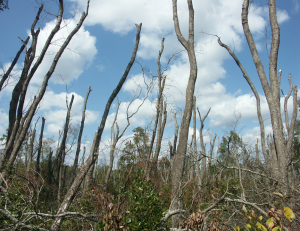Prioritizing tree species for conservation and management in changing times

The prioritization framework aims to assess the relationship for each species between the severity of threats (such as insects and disease) and two intrinsic vulnerability dimensions (Sensitivity and Low Adaptive Capacity) associated with the threats. The Sensitivity and Low Adaptive Capacity vulnerability dimensions each consists of multiple species attributes, such as rarity and dispersal ability.
SUMMARY: A variety of threats, most importantly climate change and insect and disease infestation, will increase the risk that forest trees could experience population-level or species-level extinction. Species, however, differ in important traits such as life-history strategies and population dynamics, which could drive widely varying responses to potential threats. To address this challenge, a cooperating scientist with the Eastern Threat Center is helping lead a national effort to implement a framework to prioritize forest tree species for conservation, management and monitoring in the face of multiple threats.
Scientists and natural resource managers from all three deputy areas of the USDA Forest Service are cooperating on the project, a national multi-scale prioritization of forest tree species and populations for genetic conservation and monitoring. Project CAPTURE (Conservation Assessment and Prioritization of Forest Trees Under Risk of Extirpation) establishes a framework for the categorization and prioritization of forest tree species for monitoring, conservation and management actions based on identified threats to species and their life history characteristics. The foundation of the effort is the Forest Tree Genetic Risk Assessment System (ForGRAS), which has been used to prioritize species for National Forest System conservation actions in the Southern Appalachian region and in the Pacific Northwest.
PROGRESS: Project CAPTURE consists of three phases. The first phase focused on the risk categorization and prioritization of 419 forest tree species of the contiguous 48 States and Alaska. This effort incorporated the participation and expertise of forest geneticists, ecologists, silviculturists, entomologists, and pathologists, who met at a 2014 workshop to evaluate the genetic resources of forest tree species through the application of a prioritization framework. A paper published in 2017 describes an assessment of the vulnerability of these species to climate change. Two papers published in 2019 present a vulnerability assessment of native U.S. tree species based on a comprehensive list of the insect and disease threats, and associated severities, compiled for each of the tree species. In the second phase, the assessment expanded to include the native tree species of Puerto Rico and the U.S. Virgin Islands (561 species) and Hawaii (304 species). The final phase focuses on the selection of high-risk species, within which scientists are identifying specific areas most in need of conservation activity and monitoring. A paper published in 2017 describes the prioritization of areas within the ranges of eastern hemlock and Carolina hemlock for gene conservation.
Potter, K.M., M.E. Escanferla, R.M. Jetton, G. Man, and B.S. Crane. 2019. Prioritizing the conservation needs of United States tree species: Evaluating vulnerability to forest insect and disease threats. Global Ecology and Conservation. 18(2019):e00622. https://doi.org/10.1016/j.gecco.2019.e00622.
Potter, K.M., M.E. Escanferla, R.M. Jetton, and G. Man. 2019. Insect and disease threats to United States tree species and geographic patterns of their potential impacts. Forests. 10(4). https://doi.org/10.3390/f10040304.
Potter, K.M., B.S. Crane, and W.W. Hargrove. 2017. A United States national prioritization framework for tree species vulnerability to climate change. New Forests. 48(2):275-300. DOI: 10.1007/s11056-017-9569-5.
Hastings, J.M., K.M. Potter, F.H. Koch, M. Megalos, and R.M. Jetton. 2017. Prioritizing conservation seed banking locations for imperiled hemlock species using multi-attribute frontier mapping. New Forests. 48(2):301-316.DOI: 10.1007/s11056-017-9575-7.
Westwood, M., A. Frances, G. Man, D. Pivorunas, and K.M. Potter. 2017. Coordinating the IUCN Red List of North American tree species: A special session at the USFS gene conservation of tree species workshop. Gene Conservation of Tree Species—Banking on the Future. Proceedings of a Workshop. R.A. Sniezko, G. Man, V. Hipkins, K. Woeste, D. Gwaze, J.T. Kliejunas, and B.A. McTeague, tech. coords. Chicago, Illinois, May 16-19, 2016. General Technical Report PNW-GTR-963. Portland, Oregon: U.S. Department of Agriculture, Forest Service, Pacific Northwest Research Station. pp. 12-23.
Devine, W., Aubry, C., Miller, J., Potter, K.M., and Bower, A. 2012. Climate change and forest trees in the Pacific Northwest: guide to vulnerability assessment methodology. Olympia, Washington: U.S. Department of Agriculture, Forest Service, Pacific Northwest Region. 49 p.
This research has been described in a number of presentations.
LINKS:
CONTACT: Kevin Potter, NCSU Department of Forestry and Environmental Resources, kpotter@ncsu.edu or (919) 549-4071



